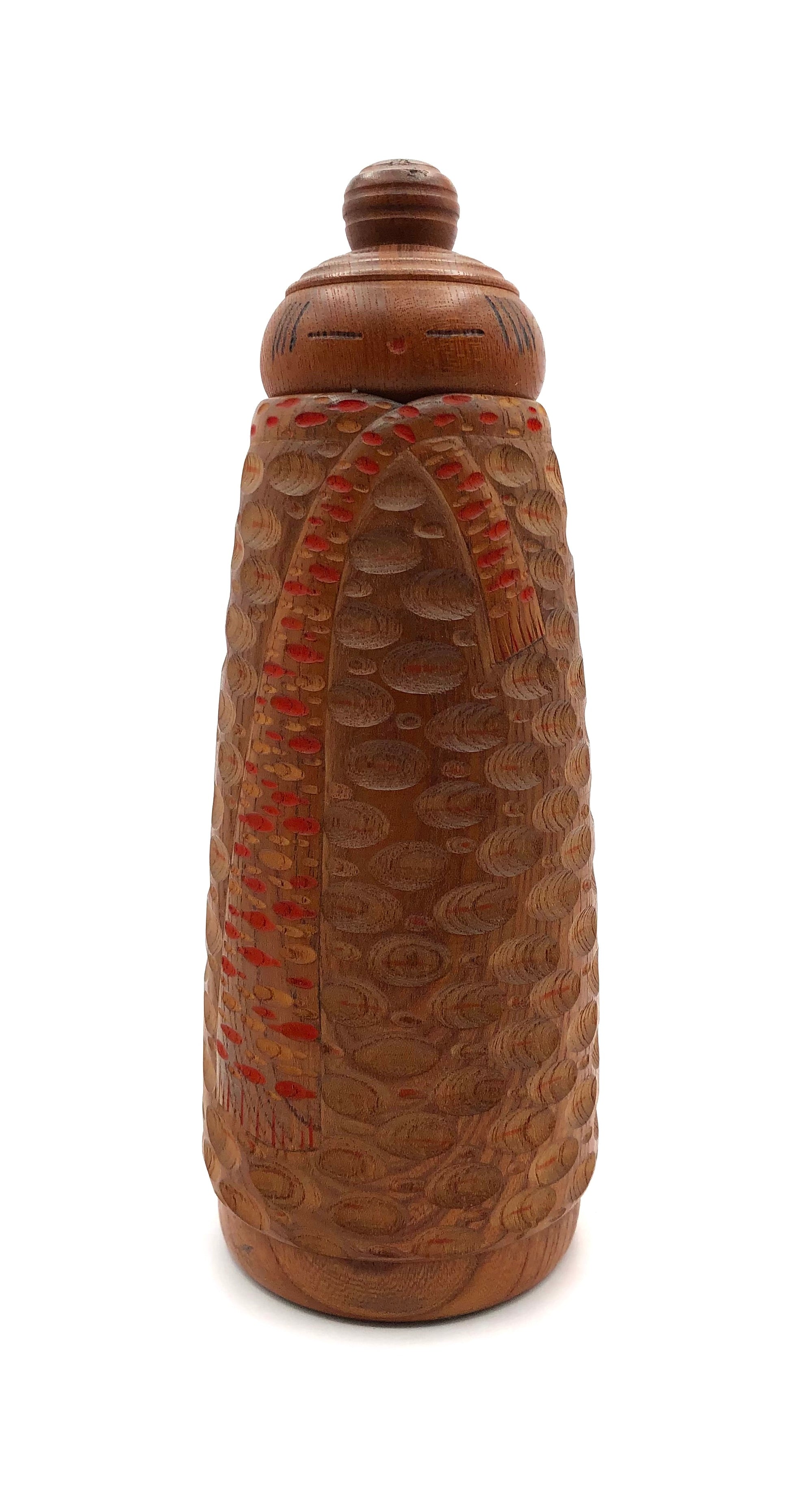


Vintage Sosaku Kokeshi entitled: “Fusetu | Wind and Snow” by Shouzan, Shido (1932-1995)
Dimensions: 10-1/2”h
Shouzan-san is considered by Kokeshi collectors and critics alike to be the most influential artist in the world of Sosaku Kokeshi doll-making, which emerged during the creative period of the ‘60s. He is a multiple winner of the Prime Minister’s Award, among many other awards.
This “Rare Find” exhibits one of Shouzan’s favored design elements: an extensive and repetitive textural treatment called ‘Harmonic Chatter work’. This random texturization enables the artist to produce some exquisite, yet unique surface treatments to represent the blanket wrap referred to as a “Kakumaki”, which is a winter shawl, that was used throughout the Northern part of Japan to throw on quickly to keep a body warm on short outings. The natural qualities of the wood are brought forward beautifully with minimal painted ornamentation. That painted surface is seen in the inclusion of a long flowing vermillion neck scarf that wraps around the shoulders and down the front of the body. Her head has a classic hairstyle with a (Mage), and the top of her head complements the wrapped hairstyle and side hair fringes framing the face. She has a small red dot for a nose. Shouzan placed his red Hanko on the bottom of the doll.
The piece was published in the 2022 publication of Sosaku Kokeshi: Celebrating the Major Artists of the Creative Movement. For more information on this artist go to the following link: https://mingeiarts.com/collections/artisan-woodworker-shido-shozan-1932-1995.
Condition: Superb lathe turning, detailing, and size, for it, is outstandingly excellent, impressive, and beautiful. There are no chips, cracks, breaks, missing pieces, or restoration, and it retains its original details and finishes. The piece meets all the standards of the vintage collectible Sosaku Kokeshi by Shouzan, Shido.

Artisan
Woodworker: Shido, Shouzan
1932-1995
Biographical History:
Shouzan began making Sosaku Kokeshi in 1959, soon after he graduated from Chuo University with a law degree. He is considered by Kokeshi collectors and critics alike to be arguably the most influential artist in the world of Sosaku Kokeshi doll-making. Shido-san’s main focus was depicting unadorned Northern girls in the traditional “Mino”, or Snow Coat, but he also produced tall, thin dolls, which were sparsely decorated. His keen sense of design, minimal use of color, and simple elegant shapes set him apart from his peers, making him one of the most collectible artists emerging from the creative period of the ‘60s winning various awards since 1961. He served as a judge of the All Japan Kokeshi Contest from 1970 to 1976. During that time Shozan published a book entitled Kizin Kasho comprising examples of his award-winning Kokeshi. His dolls have been collected and exhibited worldwide and winner of the Prime Minister’s Award, among many other awards.
Collector's note – descriptive qualities, standard characteristics & ornamentation styles:
Shito-san loved studying the use of combining different types of wood to gain the desired effect and to give dimension to his pieces. He also enjoyed creating slender, tall dolls to support the fact that they resemble the tall, thin trees seen throughout Japan. He incorporated a repetitive textural pattern called ‘Harmonic Chatter work’ to enhance the natural qualities of the wood in many of his works. He particularly enjoyed the textural qualities of ‘Chattering’ on the rain/snow coat, (Minomushi), which is a favorite theme, executed with minimal painted ornamentation, with an emphasis on the natural wood. In general, it is said that Japanese culture is one of modesty and humility. Occasionally saw different types of headdresses, one of which he called a ‘Tsunokakushi’, which is a wide headdress or hood, that covered elaborate hairstyles. We are told that the Japanese people regulate their behavior and response by reading faces and the eyes of others. Here, as well as elsewhere, you will see many examples of different characteristics of the eye's expressions. His most famous doll, which was considered a favorite was called “Mai”, a dancer, which was an elegant and slender doll with a beautifully formed Kimono focusing on traditional hair design (Mage) with an emphasis on a brightly colored “obi” which brings forth the best use of complex geometry to create traditional Japanese clothing elements which were created in 1970.
Shito-san was a prolific artist/woodworker of Kokeshi dolls some of which were whimsical, some focusing on calligraphy citing haiku (poems). We additionally see unusual subjects focused on Zen Buddhism and figures of Daruma, (Bodhidharma) of which most were made in a “roly-poly” type figure seen throughout festivals in Japan.
Explore & Learn More about Woodworker: Shido, Shouzan